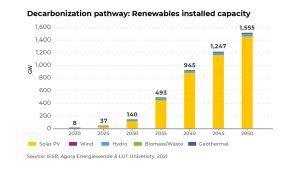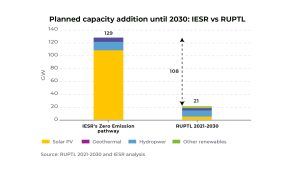Jakarta, 21 December 2021 – The unfavorable climate for renewable energy investment in Indonesia and inconsistent political commitments can hinder the achievement of the 23% renewable energy mix target by 2025. Until Q3 2021, the renewable energy mix is still at 11.2%. The Institute for Essential Services Reform (IESR) views that the Indonesian government needs to thoughtfully prepare an energy transition ecosystem to accelerate the decarbonization of the energy system in Indonesia to achieve net-zero by 2050.
In 2021, renewable energy development in Indonesia is still running slowly and not on track to the target of 23% of the renewable energy mix in 2025. IESR, in its annual report Indonesia Energy Transition Outlook 2022, found that until September 2021, the total installed capacity of renewable energy only reached 10,827 MW or increased by about 400 MW. Meanwhile, to achieve the KEN and RUEN targets in 2025, renewable energy generating capacity is estimated to reach a minimum of 24,000 MW or around 2-3 GW of additional renewable energy capacity every year. However, to comply with the Paris Agreement, it takes at least 11-13 GW of renewable energy generation to decarbonize the energy system in Indonesia, which includes the power generation, transportation, and industrial sectors by 2050. Besides, solar energy adoption is also relatively insignificant, only increasing by 18 MW, dominated by rooftop solar power plants. It is so slow compared to the need for 10-11 GW of rooftop PV mini-grid each year to encourage zero emissions by 2045 in the electricity sector. IESR views PV mini-grid as an opportunity to maximize the contribution of the community and business entities to invest in the decarbonization process.

Endeavors to decarbonize the transportation system by adopting electric vehicles and biofuels are still far from the target set. Sales of electric vehicles are still below 1% of total vehicle sales. Only about 2,000 electric cars and 5,000 electric motorcycles are registered, while the total number of electric cars and motorcycles needs to reach 1.7 million and 100 million by 2030. Biofuels are still limited to biodiesel development which is still uneconomical and constrained by sustainability issues. The implementation of B40, previously B30, which is planned for 2022 is also considered as a constraint due to the current price of palm oil.
“The government should focus on strengthening its political commitment to decarbonization by revising the National Energy Policy (KEN) and the General National Energy Plan (RUEN) to align with the goals of Net-Zero Emissions (NZE). The government needs to improve the quality of regulations to increase investment attractiveness, reduce licensing barriers, and accelerate the development and utilization of renewable energy outside PLN by maximizing the contribution of the community and business entities to invest in renewable energy generation and energy efficiency. Thus, 23% of the renewable energy mix in 2025 can be achieved,” said IESR Executive Director, Fabby Tumiwa.
The decarbonization of the energy system in Indonesia requires the readiness of a supportive ecosystem. The Indonesia Energy Transition Outlook 2022 report assesses that its enabling ecosystem is still low. Using the Energy Transition Readiness Framework, IESR evaluates four indicators, i.e. policy and regulatory support, technology and economy, climate and investment realization, and social.
Ineffective energy policy and regulatory support in boosting the development of renewable energy in Indonesia are reflecting the government’s insufficient political commitment to renewable energy. Although in 2021, the government is committed to increasing the share of the renewable energy mix to 51% in the Electricity Supply Business Plan (RUPTL) and reviewing early retirement at 9.2 GW of coal-fired power plants, these efforts are not ambitious enough to achieve carbon neutrality by mid-century, unaligned with Paris Agreement. Furthermore, this commitment needs to be translated into a clear implementation plan in 2022.

“Indeed, in 2021, there have been several policy documents issued such as LTS and RUPTL, but we evaluate these targets are still far from sufficient to limit the increase in the earth’s temperature to below 1.5 degree Celsius. It is important to improve several regulations such as renewable energy tariffs, scheduled and transparent auction and procurement mechanism from PLN, so that these targets can be achieved,” said Julius Christian, Clean Fuel Researcher & Specialist and Lead Author IETO 2022 report.
Energy policies in Indonesia also have not provided a sense of security for developers to invest in renewable energy. MEMR Regulation No 10/2017 leaves the risk to the developer if there is a change in government policy. ESDM Regulation No. 50/2017 drives renewable energy projects as difficult unbankable projects. More than that, the delay in issuing the Presidential Regulation on new and renewable energy tariffs has caused uncertainty and hampered investment in renewable energy projects in Indonesia.
Unfavorable policies had an insignificant impact on renewable energy investment, only reaching USD 1.17 billion compared to 2020 of USD 1.12 billion. This amount is very small compared to the investment needs for decarbonization of energy systems according to the IESR study, as much as USD 20-25 billion per year by 2030.
From a technical and economic point of view, globally, both renewable energy technology and costs have become increasingly competitive in recent years. The results of the last solar PV auction was electricity cost of USD 0.04/kWh, lower than the average coal power plant, which costs USD 0.05-0.07/kWh. The requirements for subsidies and government regulatory support for coal-fired power plants are allegedly making the cost of coal-fired power plants low. If using the actual market price, with a coal price of USD 150/ton (September 2021), the cost of generating electricity from a coal-fired power plant (CFPP) could reach USD 0.09-0.11/kWh.
Although renewable energy projects have become more economical, renewable energy investment is still considered less attractive.
“The main thing that needs to be highlighted is the unfamiliarity of local banks and investors to the risk of renewable energy projects which are lower than fossil energy projects, considering the price of technology in a declining global trend. The length of the permit process and the complexity of the procurement mechanism are also seen as two things that often make the financing costs of renewable energy projects higher than planned. These drive developers difficulties to determine the exact and definite number of investment needs to be submitted to funding institutions, “said Handriyanti D. Puspitarini, Renewable Energy Senior Researcher, IESR who is also involved in writing IETO 2022.
Meanwhile, from a social perspective, based on the results of a survey conducted by IESR on 1000 respondents, there is an increase in awareness and support for the energy transition to clean energy. A total of 56% of respondents (strongly) agree that Indonesia should stop using coal for power generation. The three highest renewable energy sources that receive the highest public support are solar (68%), water (60%), and wind (39%).
IESR in the IETO 2022 report encourages the Indonesian government to capture positive sentiments from the Indonesian people towards renewable energy through collaboration with the private sector, industry, and provincial governments in Indonesia. Several provinces in Indonesia, such as DKI Jakarta, Bali, Central Java, can serve as references and lessons for other provinces in developing a larger portion of renewable energy.
The focus in 2022 can be on policies and regulations that increase the transparency of the renewable energy auction process, identify clear risk allocation through standardization of Project-Based Learning (PJBL), and improve the bankability of renewable energy projects with derisking instruments. A more efficient and punctual licensing process and lower interest rates for project loans are also important factors for reducing initial funding costs and improving the investment climate.
Indonesia Energy Transition Outlook 2022 report can be downloaded at: s.id/IESR_IETO2022

